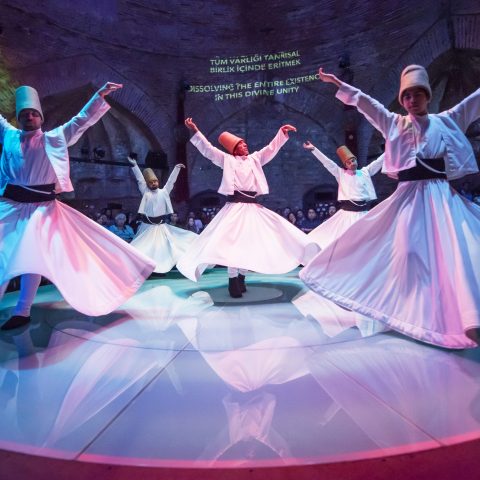Hz mevlana’s books, poems and sayings written during his lifetime.
Mesnevi
Mesnevi is the name of a style of poetry in classical eastern literature. In literature, Mesnevi is a type of verse in the same metre and each couplet rhymes separately among itself. When long-lasting subjects or stories wanted to be told through poetry, the mesnevi genre was preferred due to its ease of rhyme.
Although Mesnevi is a genre of classical eastern poetry, “Mevlâna’s Mesnevi” comes to mind when “Mesnevi” is mentioned.
Mevlana wrote the Masnavi at the request of Hüsameddin Çelebi. According to his scribe Hüsameddin Çelebi, Mevlana would recite the couplets of the Masnavi while travelling in Meram, sitting, walking, and even while performing sema. Çelebi Hüsameddin also wrote them down.
The language of Masnavi is Persian. According to the oldest available copy of the Masnavi dated 1278, which is still on display in the Mevlâna Museum, the number of couplets is 25618.
The metre of the Masnavi:
Fâ i lâ tün – fâ i lâ tün – fâ i lün.
In his 6-volume Mesnevi, Mevlana narrates his mystical ideas and thoughts in the form of interconnected stories.
DÎVAN-I KEBİR
It is called the book in which Divan poets collect their poems. “Divân-ı Kebir” means “Great Notebook” or “Great Divân”.
All of Mevlana’s poems on various subjects are in this divan. Although the language of Divân-ı Kebir is Persian, Arabic, Turkish and Greek poems are also included in it.
Divân-ı Kebir was formed by bringing together 21 small divans (Bahir) and rubâî divans. The number of couplets of Divân-ı Kebir exceeds 40.000.
Since Mevlâna wrote some of his poems in Divân-ı Kebir under the pseudonym Şems, this divân is also called Divân-ı Şems. The poems in the Divān are arranged according to rhyme and meter.
LETTERS
These are 147 letters written by Mevlâna to advise the Seljuk rulers and the dignitaries of the time, and to give explanatory information on religious and scientific issues that were asked and requested from him.
In these letters, Mevlana did not follow the rules of writing literary letters, he wrote exactly as he spoke. He never used words like “your servant, I am the sea” in his letters.
In his addresses, except for the names of positions and offices, he used whatever style of address suited him according to the mind, belief and good deeds of the person he wrote to.
FIHI MAI FIHI
Fîhi Mâ Fih means “Whatever is there is in it”. This work contains Mevlana’s conversations in various assemblies. It is believed that these were collected in a book by his son Sultan Veled. The work consists of 61 chapters. Some of these chapters were addressed to the Seljuk Vizier Süleyman Pervane. Some political events are also mentioned in the work. Therefore, this work is of great historical importance.
In the work, topics such as heaven and hell, world and hereafter, murshid and disciple, love and whirling dervish are covered.
MAJLIS-I SEB’A (SEVEN ASSEMBLIES)
As the name Mecâlis-i Seb’a suggests, it is a collection of Mevlâna’s seven assemblies and seven sermons. Mevlâna’s sermons were noted down by Çelebi Hüsameddin or his son Sultan Veled, but additions were made on the condition that the essence was not touched. It is highly probable that the work was proofread by Mevlâna after it was edited.
Mevlâna, who accepted poetry not as a goal but as a tool for expressing his ideas, divided the hadiths he commented on in his seven assemblies into the following topics:
- The way by which societies that have strayed from the right path will be saved
- Deliverance from offence, awakening from heedlessness through reason
- Power in the Faith
- Those who repent and find the right path will be Allah’s beloved servants
- Value of knowledge
- Diving into heedlessness
- The importance of reason
In these seven assemblies, 41 more hadiths are mentioned along with the hadiths that were originally commented on. Each hadith chosen by Mawlāna is a collective one. Mevlana starts each chapter with “praise and thanks” and “munajat” and makes the subjects to be explained and his mystical views attractive with stories and poems. This method was also used in the writing of the Masnavi.
-
Product on sale
 Whirling Dervish Ceremony in Hodjapasha Culture CenterOriginal price was: 1.400,00₺.1.385,00₺Current price is: 1.385,00₺.
Whirling Dervish Ceremony in Hodjapasha Culture CenterOriginal price was: 1.400,00₺.1.385,00₺Current price is: 1.385,00₺. -
Product on sale
 Real Whirling Dervish Ceremony in Fatih Every Thursday at 20:30 and Saturday at 19:00Original price was: 1.500,00₺.1.480,00₺Current price is: 1.480,00₺.
Real Whirling Dervish Ceremony in Fatih Every Thursday at 20:30 and Saturday at 19:00Original price was: 1.500,00₺.1.480,00₺Current price is: 1.480,00₺.